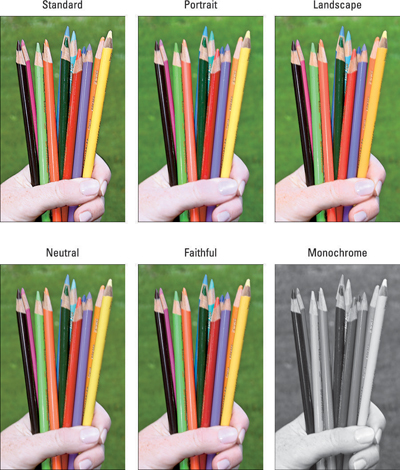Your Canon EOS 70D offers Picture Styles, which you can use to further tweak color as well as saturation, contrast, and image sharpening. Sharpening is a software process that adjusts contrast in a way that creates the illusion of slightly sharper focus. The key word here is slightly: Sharpening cannot remedy poor focus but instead produces a subtle tweak to this aspect of your pictures.
The camera offers the following Picture Styles:
Auto: This is the default setting; the camera analyzes the scene and determines which Picture Style is the most appropriate.
Standard: This option captures the image by using the characteristics that Canon offers as suitable for the majority of subjects.
Portrait: This mode reduces sharpening slightly from the amount that's applied in Standard mode, with the goal of keeping skin texture soft. Color saturation, on the other hand, is slightly increased.
Landscape: In a nod to traditions of landscape photography, this Picture Style emphasizes greens and blues and amps up color saturation and sharpness, resulting in bolder images.
Neutral: This setting reduces saturation and contrast slightly compared to how the camera renders images when the Standard option is selected.
Faithful: The Faithful style is designed to render colors as closely as possible to how your eye perceives them.
Monochrome: This setting produces black-and-white photos — or, to be more precise, grayscale images. Technically speaking, a true black-and-white image contains only black and white, with no shades of gray.
If you set the Quality option to Raw (or Raw + Large/Fine), the camera displays your image on the monitor in black and white during playback. But during the Raw converter process, you can either choose to go with your grayscale version or view and save a full-color version. Or (even better) you can process and save the image once as a grayscale photo and again as a color image.
If you don't capture the image in the Raw format, you can't access the original image colors later. In other words, you're stuck with only a black-and-white image.
The extent to which Picture Styles affect your image depends on the subject as well as on exposure settings and lighting conditions. The following figure shows you a test shot at each setting (except Auto) to give you a general idea of what to expect. As you can see, the differences are subtle, with the exception of the Monochrome option, of course.


